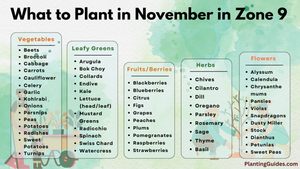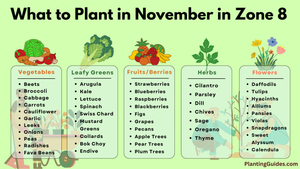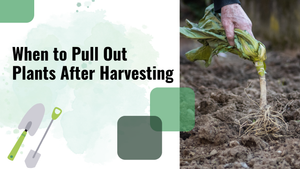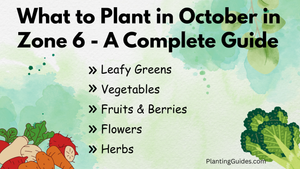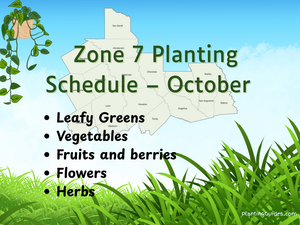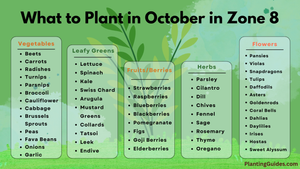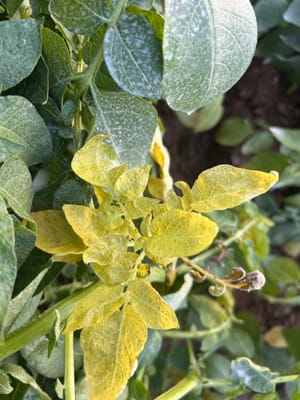Central Texas Planting Schedule - Charts
By Parvez Akhtar Pasha | Jun 04, 2025

I have been observing my parents plant and grow plants since I was a child. Now, I’m the one in charge of growing vegetables, flowers, and other plants in our garden. I have put together all my observations and experiences to create an accurate planting guide for Central Texas.
In this article, you will find a nice and clean Central Texas planting schedule with visual charts and tables.
All types of plants in a single chart may be a bit difficult to read; that's why I am separating the charts into several major categories, such as vegetables, flowers, herbs, and berries.
I know Central Texas isn't a small area, and it has two different USDA zones: 8b and 9a. Don't worry! The climate is mostly consistent, and it doesn’t significantly affect the planting schedule. I created this planting guide to show the best planting time for any plant (we usually grow) in Central Texas.
Central Texas Planting Schedule - Charts (Printable PDF version)
I hope you will enjoy the visual charts. It takes only a few minutes to read the charts, but it took me hours of work to build these charts. If possible, purchase the PDF printable chart (This is something that motivates me to build these for you).
Leafy greens planting schedule chart
| Plant Name | Best Planting Time | Planting Method | Transplanting Time | First Harvest (Days) | Variety Recommendations |
|---|---|---|---|---|---|
| Spinach | October – February | Direct Seed | Not Required | 35–50 | Bloomsdale, Space, Tyee |
| Lettuce | September – March | Transplant or Direct Seed | 2–3 weeks after seeding | 30–60 | Buttercrunch, Romaine, Black Seeded Simpson |
| Kale | September – February | Transplant or Direct Seed | 3–4 weeks after seeding | 50–70 | Dwarf Blue Curled, Lacinato, Red Russian |
| Swiss Chard | September – April | Direct Seed | Not Required | 50–60 | Bright Lights, Fordhook Giant, Ruby Red |
| Mustard Greens | October – March | Direct Seed | Not Required | 30–50 | Southern Giant Curled, Green Wave |
| Collard Greens | September – February | Transplant or Direct Seed | 3–4 weeks after seeding | 60–80 | Georgia Southern, Vates |
| Arugula | October – March | Direct Seed | Not Required | 20–40 | Rocket, Astro, Slow Bolt |
| Bok Choy (Pak Choi) | September – February | Transplant or Direct Seed | 3–4 weeks after seeding | 45–60 | Joi Choi, Mei Qing Choi |
| Endive | October – February | Transplant | 4 weeks after seeding | 50–80 | Frisée, Green Curled Ruffec |
| Watercress | October – March | Transplant or Container | 3–4 weeks after seeding | 60–70 | Aquatic, Upland |
| Mizuna | October – March | Direct Seed | Not Required | 30–50 | Kyoto Mizuna, Early Mizuna |
| Tatsoi | October – March | Direct Seed | Not Required | 30–45 | Rosette Tatsoi, Yukina Savoy |
| Malabar Spinach | April – July | Transplant or Direct Seed | 2–3 weeks after seeding | 40–60 | Red Stem, Green Stem |
Visual Chart:
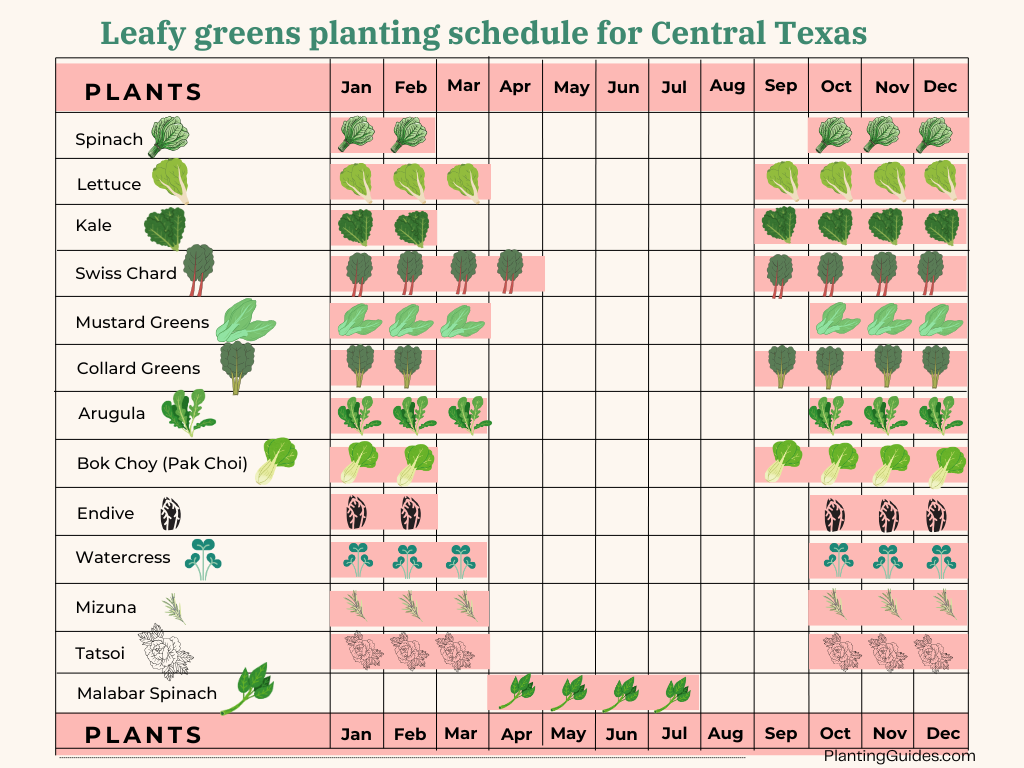
Not all the vegetable varieties can perform good in Central Texas. I have added an extra column to give variety recommendations for the specific vegetables and leafy greens.
I’ve added three variety suggestions for each vegetable. As it comes down to personal preference, feel free to choose the one that suits you best.
In summer, there is a chance that your plants will meet regular pests. I have created a separate guideline on that. Feel free to check: organic pest control methods for your garden
( I prefer organic ways to control pests and soil improvement )
Vegetable Planting Guide for Central Texas - Schedule Chart
| Plant Name | Best Planting Time | Planting Method | Transplanting Time | First Harvest (Days) | Variety Recommendations |
|---|---|---|---|---|---|
| Tomato | February – March, July (fall crop) | Transplant | 6–8 weeks after seeding | 60–90 | Celebrity, Roma, Sun Gold, Juliet |
| Asparagus | Late January – February | Crowns (roots) | Not applicable (planted directly) | Second year (full harvest in 3rd year) | Jersey Giant, Jersey Knight, Mary Washington |
| Bell Pepper | March – April | Transplant | 6–8 weeks after seeding | 60–90 | California Wonder, Big Bertha |
| Broccoli | September – October, February | Transplant | 5–6 weeks after seeding | 60–85 | Packman, Green Magic, Waltham 29 |
| Pinto Beans | Mid-March – April | Direct Sow | Not Applicable | 85–105 | Burke, Othello, Sierra |
| Sweet Potatoes | April – May | Slips (rooted cuttings) | Not Required | 90–120 | Beauregard, Georgia Jet, Centennial |
| Hot Pepper | March – April | Transplant | 6–8 weeks after seeding | 60–90 | Jalapeño, Serrano, Habanero |
| Eggplant | March – May | Transplant | 6–8 weeks after seeding | 60–85 | Black Beauty, Ichiban, Rosa Bianca |
| Okra | April – July | Direct Seed | Not Required | 50–70 | Clemson Spineless, Emerald |
| Cucumber | March – May, August | Direct Seed or Transplant | 2–3 weeks after seeding | 50–65 | Marketmore 76, Straight Eight, Lemon |
| Squash (Summer) | March – May, August | Direct Seed | Not Required | 45–60 | Yellow Crookneck, Zucchini |
| Squash (Winter) | March – April | Direct Seed | Not Required | 80–110 | Butternut, Acorn, Spaghetti |
| Green Beans | March – May, August | Direct Seed | Not Required | 50–60 | Contender, Blue Lake, Provider |
| Lima Beans | April – June | Direct Seed | Not Required | 65–90 | Henderson Bush, Fordhook |
| Carrots | September – February | Direct Seed | Not Required | 60–80 | Danvers, Nantes, Little Finger |
| Beets | September – February | Direct Seed | Not Required | 55–70 | Detroit Dark Red, Chioggia, Golden |
| Radish | September – March | Direct Seed | Not Required | 25–35 | Cherry Belle, French Breakfast |
| Turnips | September – February | Direct Seed | Not Required | 50–70 | Purple Top, Hakurei |
| Onions (Bulb) | November – January (from transplants) | Transplant | Not Applicable | 100–120 | Texas Sweet, 1015Y |
| Garlic | October – December | Clove (Direct Planting) | Not Required | 180–210 | California Early, Creole Red |
| Potatoes | January – February | Seed Pieces | Not Required | 90–120 | Yukon Gold, Red LaSoda, Kennebec |
Visual Chart:

Growing vegetables in Central Texas is not so hard. You just need to use organic composts wisely.
If you want to make organic compost at home, this is for you: Best homemade organic fertilizer
Fruits & Berries Planting Schedule for Central Texas
| Plant Name | Best Planting Time | Planting Method | First Harvest (Days) | Variety Recommendations |
|---|---|---|---|---|
| Apple | December – February | Bare-root or Container | 730–1095 (2–3 years) | Anna, Dorsett Golden, Ein Shemer |
| Pear | December – February | Bare-root or Container | 730–1095 (2–3 years) | Kieffer, Orient, Warren |
| Peach | December – February | Bare-root or Container | 730–1095 (2–3 years) | Harvester, June Gold, TexPrince |
| Plum | December – February | Bare-root or Container | 730–1095 (2–3 years) | Methley, Santa Rosa, Morris |
| Fig | January – March | Container or Bare-root | 365–730 (1–2 years) | Celeste, Texas Everbearing, Alma |
| Pomegranate | January – March | Container or Bare-root | 365–730 (1–2 years) | Wonderful, Granada, Austin |
| Persimmon | January – March | Container or Bare-root | 730–1095 (2–3 years) | Fuyu, Hachiya, Saijo |
| Citrus | February – April | Container (grafted) | 730–1095 (2–3 years) | Meyer Lemon, Satsuma, Valencia |
| Blackberry | December – February | Bare-root or Container | 365–730 (1–2 years) | Brazos, Brison, Rosborough |
| Raspberry | December – February | Bare-root or Container | 365–730 (1–2 years) | Heritage, Dormanred, Fall Gold |
| Strawberry | October – November | Transplant (Annual) | 90–120 | Chandler, Seascape, Camarosa |
| Blueberry | December – February | Container (acidic soil) | 365–730 (1–2 years) | Austin, Brightwell, Climax |
| Grape | January – February | Bare-root | 730–1095 (2–3 years) | Black Spanish, Champanel, Blanc du Bois |
| Elderberry | January – March | Bare-root or Container | 365–730 (1–2 years) | Sambucus nigra, Sambucus canadensis |
Visual Chart:
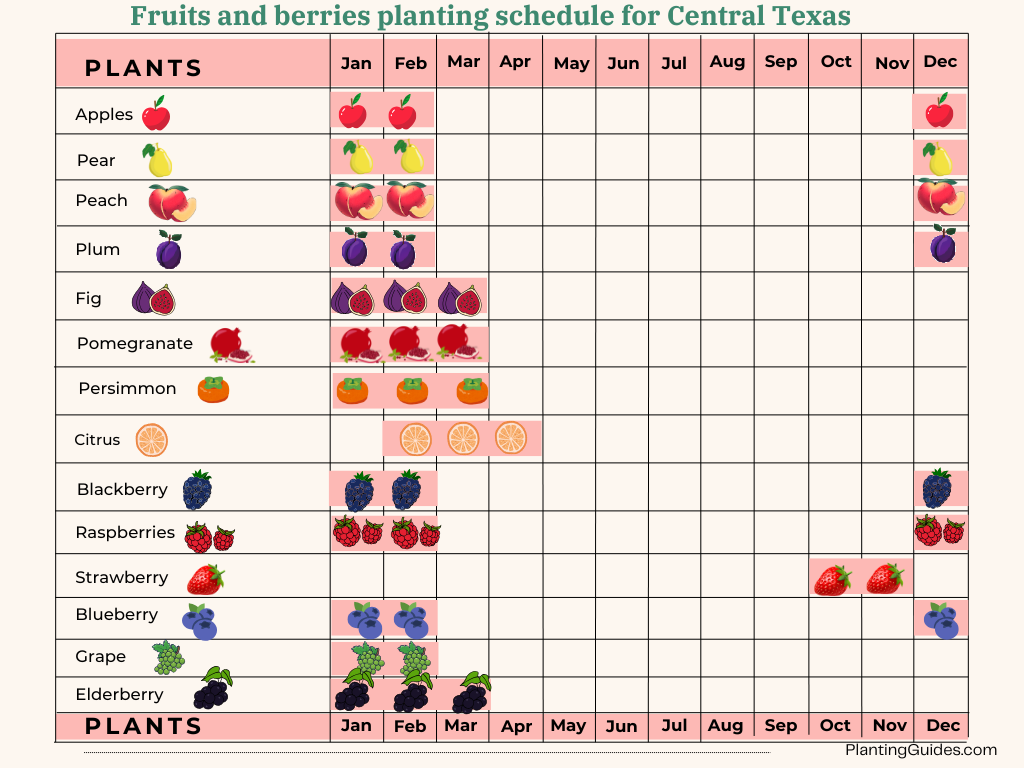
If you started a fruit tree in a container, then only you should transplant it into the ground or into a larger pot.
I usually prefer to plant only once, which does not require transplantation.
Flowers Planting Schedule Chart - Central Texas
| Flower Name | Best Planting Time | Planting Method | Transplanting Time | First Bloom (Days) | Perennial or Annual |
|---|---|---|---|---|---|
| Marigold | March – May | Direct Seed or Transplant | 4–6 weeks after seeding | 45–60 | Annual |
| Zinnia | April – June | Direct Seed | Not Required | 50–70 | Annual |
| Black-eyed Susan | March – May | Transplant or Direct Seed | 6–8 weeks after seeding | 70–100 | Perennial |
| Lantana | March – May | Transplant | 6–8 weeks after seeding | 70–90 | Perennial |
| Mexican Petunia | March – May | Transplant | 6–8 weeks after seeding | 60–90 | Perennial |
| Sunflower | March – May | Direct Seed | Not Required | 70–100 | Annual |
| Cosmos | April – June | Direct Seed | Not Required | 50–70 | Annual |
| Purple Coneflower | March – May | Transplant or Direct Seed | 6–8 weeks after seeding | 80–120 | Perennial |
| Bluebonnet | September – November | Direct Seed | Not Required | 150–180 | Annual |
| Coreopsis | March – May | Transplant or Direct Seed | 6–8 weeks after seeding | 70–100 | Perennial |
| Snapdragon | October – November | Transplant | 6–8 weeks after seeding | 100–120 | Annual |
| Pansy | October – November | Transplant | 6–8 weeks after seeding | 60–90 | Annual |
| Petunia | March – May | Transplant | 6–8 weeks after seeding | 60–80 | Annual |
| Larkspur | October – November | Direct Seed | Not Required | 90–120 | Annual |
| Hibiscus (Hardy) | March – May | Transplant | 6–8 weeks after seeding | 120–150 | Perennial |
Visual Chart:

There are several flowers in the above list that have some herbal uses too.
You may go for any variety you like to grow.
Lantana should be in your garden if you are growing veggies and fruit trees. Lantana attracts a lot of pollinators, and they will help to pollinate your fruits and berries.
Herb Planting Schedule for Central Texas
| Herb Name | Best Planting Time | Planting Method | Transplanting Time | First Harvest (Days) | Variety Recommendations |
|---|---|---|---|---|---|
| Basil | March – May | Direct Seed or Transplant | 4–6 weeks after seeding | 60–90 | Genovese, Thai, Lemon |
| Cilantro | October – February | Direct Seed | Not Required | 30–60 | Santo, Slow Bolt |
| Parsley | October – February | Direct Seed or Transplant | 4–6 weeks after seeding | 70–90 | Italian Flat Leaf, Curled Leaf |
| Dill | October – February | Direct Seed | Not Required | 40–60 | Bouquet, Fernleaf |
| Mint | March – May | Transplant or Cuttings | 4–6 weeks after rooting | 60–90 | Spearmint, Peppermint |
| Rosemary | March – May | Transplant or Cuttings | 4–6 weeks after rooting | 90–120 | Arp, Hill Hardy |
| Thyme | March – May | Transplant or Cuttings | 4–6 weeks after rooting | 90–120 | English Thyme, Lemon Thyme |
| Oregano | March – May | Transplant or Cuttings | 4–6 weeks after rooting | 90–120 | Greek Oregano, Italian Oregano |
| Chives | October – February | Direct Seed or Transplant | 4–6 weeks after seeding | 60–90 | Common Chives, Garlic Chives |
| Lavender | March – May | Transplant | 6–8 weeks after seeding | 120–150 | English Lavender, Spanish Lavender |
Visual Chart:

Share with your Central Texas gardener friends. They will love it as you did.
